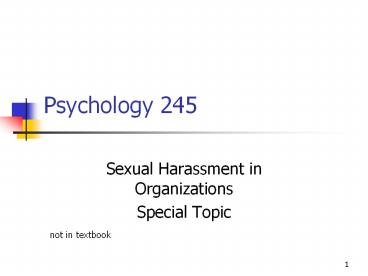Individual deviance model ... Structural models ... - PowerPoint PPT Presentation
1 / 17
Title:
Individual deviance model ... Structural models ...
Description:
Individual deviance model ... Structural models ... A predominance of male supervisors. Jobs traditionally reserved for men. 12 ... – PowerPoint PPT presentation
Number of Views:119
Avg rating:3.0/5.0
Title: Individual deviance model ... Structural models ...
1
Psychology 245
- Sexual Harassment in Organizations
- Special Topic
not in textbook
2
sexual harassment
- Sexual harassment
- defined as offensive, sex-related behavior.
- unwanted attention at workplace
- from men to women
3
Sexual Harassment
- Models of sexual harassment
- Natural/biological model
- Sexual harassment (SH) is part of the natural
interactions between men and women. - Individual deviance model
- Something about the harasser certain attitudes
toward women, personality, acceptance of myths
causes them to engage in Sexual Harassment (SH). - Structural models
- Culture, demographic makeup or other
characteristics of the organization give rise to
a climate that makes SH more likely to occur. - male dominated organization
4
Legal classification of SH
- Legal
- Quid pro quo -- this for that
- Attempts to extort sexual cooperation through
subtle or explicit threats of job-related
consequences. - Hostile environment
- Pervasive verbal or physical conduct of a sexual
nature that is offensive and unwelcome - Behavior that places woman as a sexual being
5
Behavioral classification of SH
- Gender animosity/harassment
- Offensive, derogatory, or misogynistic (hating
women) verbal, physical or symbolic behavior
w.r.t sex. - Designed not to elicit sexual cooperation but
rather to convey sexist, demeaning or hostile
attitudes about women. - E.g. Dont worry your pretty little head about
all those numbers.
6
More behavioral definitions
- Unwanted Sexual Attention
- Sexual attention of a verbal or physical nature
that is unwarranted, repeated and/or offensive - but that carries no explicit or implied
job-related benefit or loss. - E.g. An unsolicited back-rub.
- Sexual Coercion
- The implicit or explicit conditioning of a
job-related benefit or loss on sexual or social
cooperation. - Eg If you sleep with me, Ill give you a
raise. - Eg If you dont sleep with me, life could get
very difficult for you around here.
7
Relationships between the classification systems
Gender Harassment
Unwanted Sexual Attention
Sexual Coercion
its the guys who exhibit some behavior that are
more likely to go all the way
Hostile Environment
Quid Pro Quo
8
Research Approach
- Conceptualization of sexual harassment as one
type of job stressor. - Stressor An environmental event that is
perceived by an individual to be threatening. - As with any stress, research focus is on
- Measurement of stressor
- antecedents
- consequences
9
Measurement of SH
- Labeling approach
- Ask respondent if she has experienced SH.
- Item based approach
- Fitzgeralds Sexual Experiences Questionnaire
(SEQ). - Specific questions about what behaviors or
experiences individuals have encountered at work. - Eg someone cracked sexist jokes at work
- you were denied opportunities for promotion
because of a refusal to comply with sexual
favors. - Strongly Agree - Strongly Disagree
10
Dispositional antecedents of sexual harassment
- Who is likely to harass?
- Men with certain dispositional/personality
characteristics are likely to harass when
organizational conditions allow them to do so. - Characteristics
- 1. Have difficulty assuming others perspectives
(cant emphathsize) - 2. Endorse traditional sex-role stereotypes
- 3. High in authoritarianism
- 4. High likelihood of rape (if undetectable)
- However, by far the best predictors of sexual
harassment are organizational/situational.
11
Organizational antecedents of sexual harassment
- Job Gender Context
- Skewed gender ratio (favoring men) of employees.
Guys club - A predominance of male supervisors
- Jobs traditionally reserved for men
12
- Organizational Context
- Tolerant Organizational Climate
- 1. Lenient management norms
- 2. Managers model inappropriate behavior
- 3. Sexual workplace (stripclubs on lunch)
- 4. Lack of clear policies and procedures
- Leads employees to believe that
- 1. Sexual harassment is not taken seriously
- 2. It is risky to complain about harassment
- 3. There is little likelihood of meaningful
sanctions for harassers
13
Gutek (1985)
- Conducted telephone interviews
- 827 working women, 405 working men.
- Major finding
- SH more common in organizations where flirting
and swearing were commonplace. - Conclusion
- SH is part of a cluster of unprofessional
behavior and attitudes that characterizes some
work place
14
Consequences of sexual harassment
- Job-Related
- Impaired relationships with supervisors and
coworkers - less commitment to organization
- more Work Withdrawal and Job Withdrawal
- Psychological and Physiological
- Decreased self esteem, life satisfaction and
satisfaction with health. - Increased anxiety, depression and risk of eating
disorders and Post-Traumatic Stress Disorder. - Increased fatigue, headaches.
15
- Consequences for non-harassed women employees
- Sexual harassment is ambient.
- It creates a stressful environment even for women
not directly harassed. - Consequences similar to those for harassed women.
16
Reporting sexual harassment
- Contrary to public belief, complaints of sexual
harassment are relatively rare. - 3 Factors related to reporting
- Frequency and severity of behavior (vely
related) - Supportive organizational climate (vely related)
- Power of perpetrator (-vely related)
- the more powerful he is, the less likely you are
to report
17
Effectiveness of reporting
- Every research study on this topic has concluded
that reporting either - Makes no difference, or
- Makes things worse
- Given the immense psychological and economic
costs to individuals who use formal action, in
contrast to the potentially meager gains, it is
not surprising that so few victims choose this
response. - Livingstone (1982, p. 15)































